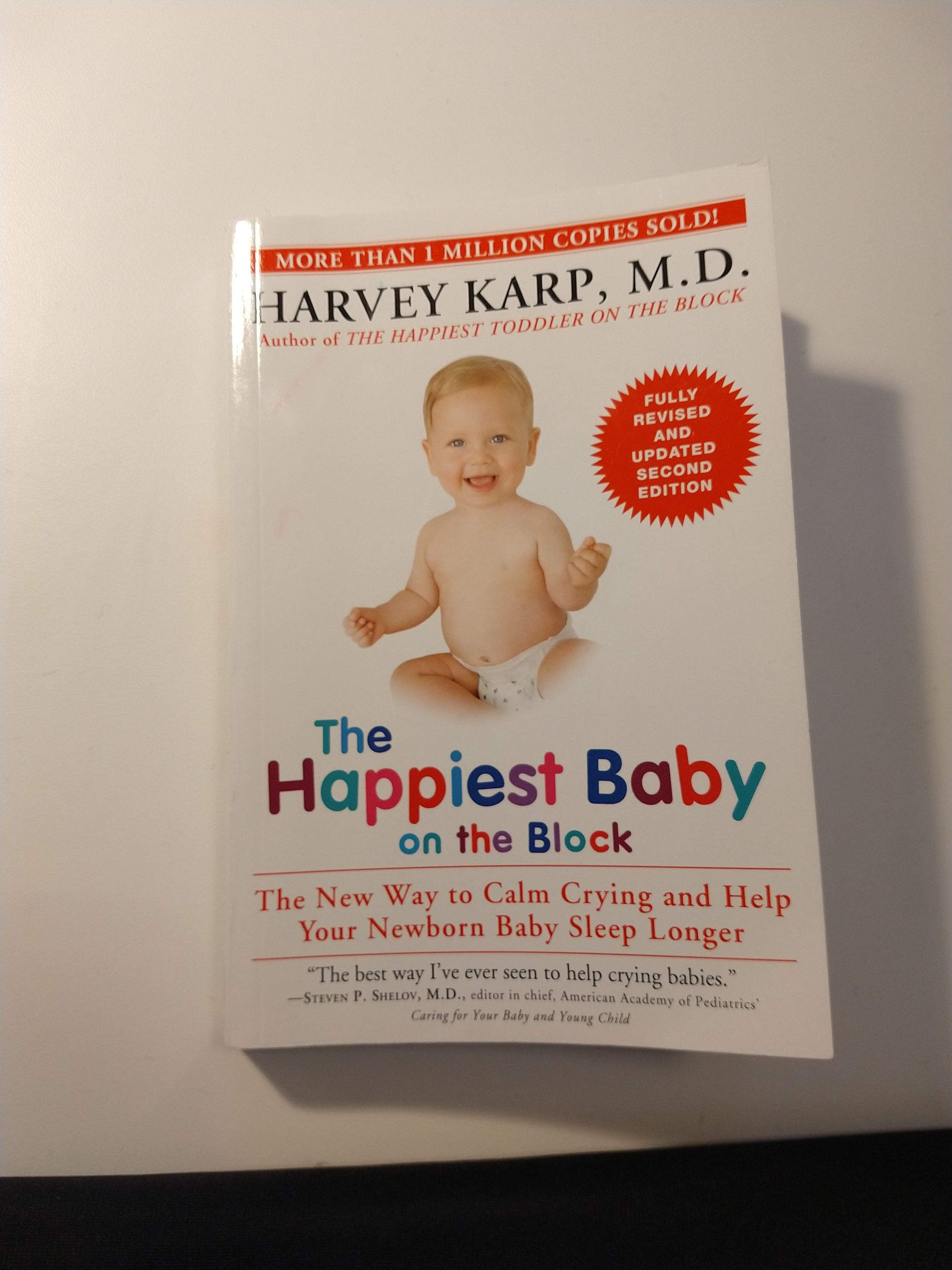This book will guide parents in soothing a fussy or colicky baby. With the multitude of perspectives and knowledge on baby care in recent years, Harvey Karp, M.D. has developed the 5 S's technique: swaddling, side/stomach-laying, shushing, swinging, and sucking. The 5 S's can help babies during transition periods, from the mother's womb to the outside world, by recreating the womb experience.
Using the 5 S’s
Start practicing the technique when the baby is asleep and calm.
(1) Swaddling - Wrapping (Baseline)
- Context: Babies are familiar with the feeling of being wrapped in the womb. Swaddling prevents them from flailing and moving their hands, while also imitating the continuous touch and snug cuddling of the womb.
- When to use: Start swaddling from day one, but only during sleep and crying periods. This is the first step, and the next steps (S's) will not work as well without it.
- When to wean: After the baby is at least 4-5 months old.
- Note:
- Use a snug wrap to tightly swaddle the baby. The hands should be straight, but the knees can bend, and the hips should easily flex and open.
- Swaddling is most needed from 2-4 months of age.
- Check the baby's ears; if they are red and hot and the neck is sweaty, the baby may be overheating. The ears should be "fresh."
- Use the DUDU-Wrap Technique for swaddling. For more information, visit this link.

(2) Side - Laying down on stomach
- Context: This position is associated with the Moro or "I am falling" reflex, and it can help babies feel calm. Additionally, it mimics the position they experienced in the womb, where they floated as a fetus.
- When to use: After swaddling the baby, when the baby is not hungry, and with supervision.
- When to wean: Between 4-6 months.
- Note:
- Never leave the baby unsupervised in this position, especially at night.
- The safest sleep position is on the back, but laying on the belly can be the most soothing position.
(3) Shushing - White Noise or Shushing as loud as a baby's crying
- Context: Babies experience constant loudness in the womb, such as blood flow or the mother's heartbeat.
- When to use: Every night and during naps. Even if the baby sleeps well and remains calm. For manual shushing, place the mouth 2 inches from the baby's ear.
- When to wean: At 12 months.
- Note: Use white noise at 85 dB when the baby is crying, and 65 dB when the baby is calm. If shushing manually, match the loudness to the baby's crying.
(4) Swinging - jiggling motions or tiny rhythmic movements
- Context: In the womb, the baby is constantly moving due to the placenta, especially when the mother is moving.
- When to use: If the baby is unhappy, you can try the following actions: using slings, dancing with quick little moves up and down, giving rhythmic pats on the back or bottom, bouncing on the bed, rocking in a rocking chair, going for car rides, using infant swings, bouncing on an exercise ball, taking brisk walks, and using jiggly smart sleepers (p. 158).
- When to wean: Between 3-4 months.
- Note:
- Do not put the baby in a swing when he is screaming.
- Swinging is different from shaking - swinging is done side to side or up and down.
- Swing the baby only in a 1-2 inch range back and forth, and the motion should be swift, around 2-3 times per minute.
- The motions are fast but tiny, and the baby's head and neck should always be supported and in line with the body.
(5) Sucking - Breastfeeding, a clean finger, or Pacifier
- Context: Babies have a natural sucking reflex, and breastfeeding is essential for their survival. While a pacifier can provide a sense of calmness, it should be introduced only after breastfeeding has been well established. For the first 6 months, babies can thrive solely on breast milk, and after that, they can gradually introduce supplemental foods while still breastfeeding.
- When to wean using a pacifier: Around 6-7 months.
- When to wean breastfeeding: The duration depends on various factors, but ideally, it is recommended to continue breastfeeding for at least 6 months. Breastfeeding helps with bonding, provides valuable insights into the baby's well-being, and offers the best nutrition tailored to the baby's needs. Additionally, it boosts immunity, protects against obesity, reduces the risk of Sudden Infant Death Syndrome (SIDS), and lowers a woman’s risk of breast and ovarian cancer.
Summary:
- (1) Swaddling helps recreate the feeling of being in the womb. (2) Side/stomach-laying mimics the floating sensation. (3) Shushing replicates the womb's loud sounds. (4) Swinging imitates the constant movement in the womb. And (5) sucking provides comfort through breastfeeding or a pacifier. Each technique has specific guidelines and weaning recommendations.
- Correlation of the 5 S's Techniques and the calming reflex: Calming is like dancing, but in this case, the baby takes the lead.
- Swaddling and side position help initiate the calming process by restricting flailing movements.
- Shushing and swinging interrupt the crying cycle.
- Sucking helps maintain the reflex.
- Easy babies need 1 or 2 of the S's to feel calm and serene; über-cranky babies need 3-4, and the fussiest babies need all 5 S's. Parents need to find the baby's favorite S's and start adding them one by one to see how many it takes to settle the baby down: Shushing —> Swaddling —> Side/Stomach lying —> Swinging —> Sucking.
- Other remedies for a colicky baby include massage and taking walks in the fresh air (p. 194 ff).
- If the baby remains fussy even after correctly applying the techniques (i.e. precision, practice, and vigor), there may be other reasons, such as health problems.
- There are three levels of feeling uncomfortable:
- Whimper = a request.
- Cry = kitchen timer goes off to summon attention.
- Shriek = Smoke alarm.
- Colic or fussiness typically starts around 2 weeks, peaks at 8 weeks, and ends around 3 months. It tends to worsen in the evening or during the "witching hour."
- In some cultures, mothers hold their babies almost 24 hours a day and breastfeed them frequently throughout the day and night (not just 6-8 times, but even offering it hundreds of times). They also respond to the babies' cries within 10 seconds.
- Reverse psychology:
- When a baby is sucking on a pacifier, gently tug on it as if you are going to take it out. This trains the baby to suck properly on the pacifier.
- Awaken the baby after feeding, before putting him into bed.
- Routine/Scheduling (p. 227):
- Carry the baby frequently during the day to help him learn the difference between day and night.
- During the day, feed the baby every 1 - 1.5 hours, then put him to sleep.
- Start the nap before the baby starts yawning and shows droopy eyes.
- Wake the baby if their nap lasts over 2 hours, as long naps can result in less daytime eating and increased hunger at night.
- Feed the baby in a quiet room to prevent distractions and refusal to eat.
- Turn on white noise and dim the lights 20 minutes before naps and bedtime.
- Wake the baby for a dream feed between 22:00 and 24:00 to fill his stomach and prepare him for longer sleep periods.
- Note: It is important to follow the same procedure, such as using low lights, soft white noise in the background, giving a loving massage with warm oil, offering yummy milk, swaddling the baby, and playing a soft lullaby.
What I have learned:
- The role of a parent is to assist during this transition period, similar to the manager's role during the onboarding phase for a new employee.
- Babies cry not because of bad intentions or to mock their parents but as a survival instinct and reflex. It is a natural part of their early life as they navigate and explore the world. During this transitional period, it is crucial to offer support. There is no need to discipline a baby or be concerned about them becoming dependent. The more physical affection and comfort a baby receives, the stronger and happier they will become, and the more they will develop trust in their parents and their surroundings.
- Lower my expectations, embrace uncertainty, and accept imperfection.
- Having a baby is a unique experience, and parents cannot fully prepare themselves or avoid mistakes. Even parents who have already had a baby will face new challenges with each different baby and family dynamic. Reading and learning about techniques can be helpful, but parents should decide which techniques align with their lifestyle and principles.
- Reevaluate my way of life in general, regardless of social expectation
- It is important to note that some research is funded by influential companies that may promote the consumption of formula milk, the use of prams or buggies, and even disposable diapers. However, our ancestors have provided many examples, such as using slings to carry the baby, that offer alternative approaches. These ancestral practices also encourage us to reevaluate current socialization practices related to nursing a baby and our way of life in general.
Resources:
- Karp, H., MD. (2015). The Happiest Baby on the Block; Fully revised and updated second edition: The New Way to Calm Crying and Help Your Newborn Baby Sleep Longer. Bantam.
- Karp, H., MD. (2023, 2 November). Karp, Harvey. How To Swaddle a Baby - Using the “DUDU” Method. https://happiestbaby.com.au/blogs/baby/dudu-swaddle
(Last updated: 02 November 2023)



